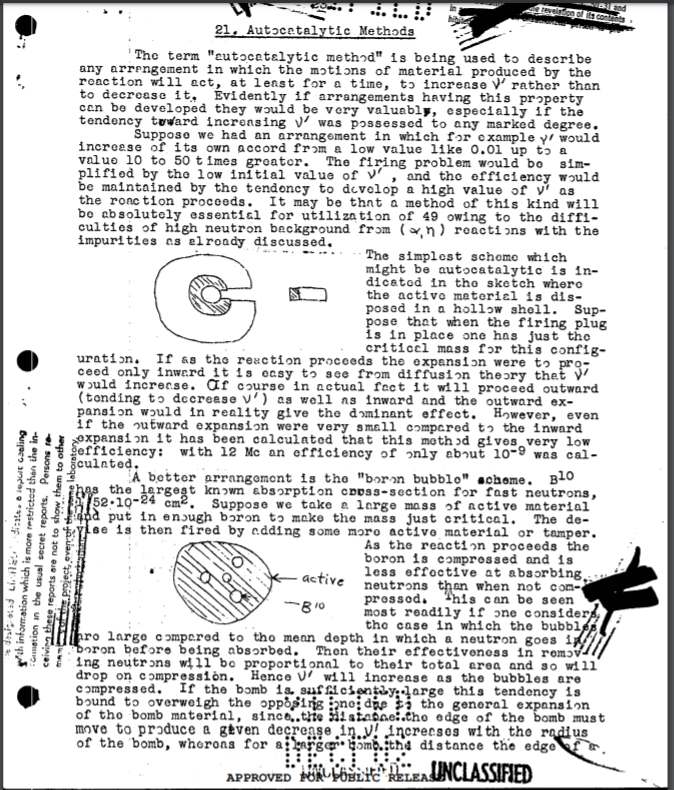
by Ida Moya
New Toys for Los Alamos
As the Traveler said, things have really been heating up in Los Alamos Scientific Laboratory (LASL). And what with President Kennedy being taken from us so traumatically last year, it has all been too much. We have been struggling with national security while mourning the loss of our leader, and also attending to a deluge of new computers that are coming into the lab. Things have calmed down a little so I am now able to share a few secrets with you again.

Page from the Los Alamos Scientific Laboratory report LA-1
I've been busy helping with the preparation of the upcoming declassification of the Los Alamos Primer. This is the very first official technical report we produced at LASL, numbered LA-1. It is based on 5 lectures introducing the principles of nuclear weapons. These lectures were given in 1943 by LASL librarian Charlotte Serber’s husband, the physicist Robert Serber. You bet it's release took a long time to get this approved. Doing the work to cross out all those “Secret Limited” stamps and restamp each page with "Unclassified" also took some time.
Los Alamos is so important to the nation’s top-secret defense work that we are able to commandeer the first of each of the fastest computers manufactured. We had Serial no. 1 of the IBM 701 “Defense Calculator” in 1953. LASL also tested one of the first of 8 IBM 7030 “Stretch” computers, which even with its uptime shortcomings can calculate so fast that some people call it a “Supercomputer.”
I’m sure I also told you that we finally received our IBM 7090 computer. This equipment is being used for big science calculations around atomic energy, guided missile control, strategic planning (cryptanalysis, weather prediction, game theory), and jet engine design. I'm sure it is no surprise when I tell you we are using it to simulate nuclear explosions. This computer also has what they call an “upgrade,” the addition of more memory and input-output capability. The upgraded computer is called an IBM 7094.
Scientists at LASL, Lawrence Livermore Radiation Laboratory, and Massachusetts Institute of Technology have been working on better ways for computer operators to use the IBM 7094. Rather than custom-writing each computer operation and calculation that have to be done, they are working on a kind of “supervisor” to allow for more than one person to use the computer at the same time. This "operating system" is called CTSS or Compatible Time Sharing System.

I don't have a current picture of Marge, but here is MIT Professor Robert Fano using CTSS from a Teletype ASR 35.
Sharing the Wealth
It's difficult to convey just how important this will be. Computers are hideously expensive things, often costing hundreds of thousands of dollars. They are also vital for any scientific institution's operations. Currently, only one person at a time can use them, which results in one of two situations. Either one person at a time has a monopoly on the machine during for the time it takes to compose and enter a program into the machine (incredibly inefficient) or programs are written "off-line" and run in a "batch". This latter solution ensures that the computer is always running, but it means no one can access the computer in real-time, and it might take days to get results (or notice that the program failed to run correctly!)
With time-sharing, several people can use a computer at once, running different programs in real-time. While the performance might not be as efficient for the computer, since it is accommodating multiple processes at once, the increased efficiency for the operator should more than make up for it.
One of my colleagues at MIT, Marjorie Merwin-Dagget, co-wrote a paper with Robert C. Daly and MIT lab head Fernando J. Corbato (Corby) about the CTSS operating system. You can have a look at it here An Experimental TIme Sharing System.
The Mother of Invention
Marge majored in math, taught for a couple of years, then found a position doing calculations and differential equations at an engineering lab. In the mid-50s, one of Marge’s female colleagues at this lab was sent to MIT to learn about the Whirlwind computer, and when this colleague came back, she taught her about how to code for Whirlwind.
Marge then leveraged this knowledge to code applications for a card punch calculator, an IBM 407 accounting machine, which was much quicker than the manual equipment their lab had been using. This clever coding work helped her land a job from Prof. Frank Verzuh in the MIT computer center. Marge got her friend Robert "Bob" Daly a job there too, because he was so skilled programming the IBM 407.

The IBM 407 Accounting Machine is "programmed" by changing wires on this plugboard.
One of Marge's first assignments was to compare assembly language programming to FORTRAN programming. Her findings are that FORTRAN is quicker to use and easier for other programmers to understand. She quickly became the FORTRAN expert of her group. She even got to work with the brilliant John McCarthy. John has been promoting the notion of timesharing computer systems at MIT and beyond. These computers are so fast that, John reasons, that several people can use them at once.
Marge tells me that Corby thought she and Bob are the best programmers on the staff. CTSS started as a demo, to demonstrate the feasibility of computer timesharing. This demo turned into a viable system, something people wanted to actually use. She worked one-on-one a lot with Corby, rehashing the problems. They ended up working a lot at odd hours, staying up late going over listings and working out the problems. Kind of like those “hackers” I told you about last year. She was so excited when she told me that it finally worked for two Flexowriters.

MIT's Fernando Corbato standing amidst some of an IBM 7090 computer system at MIT.
Corby worked on programming the supervisor and queueing, while Marge took the task of coding interrupt handling, saving the state of the machine, commands, character handling, and a method for inputting and editing lines for the demos. Bob Daly was best at translating this to the mechanical working of the computer.
After co-writing this paper, Marge got married and took a leave of absence after her first child was born. She did return to MIT last year (1963), and is working part-time on smaller support projects outside the mainstream of CTSS development. It’s troubling how difficult it is for a woman to juggle fulfilling technical work with the demands of raising a young family.
Things to Come
Next time, I will tell you about our newest Supercomputer, the CDC 6600. This remarkable machine, designed by that wag Seymour Cray, is being installed in Los Alamos Scientific Laboratory right now. It is so fast and hot that it has to be cooled by Freon, which is making for a lot of fuss with air conditioning technicians coming and going to the lab. I spend a lot of time making copies of "Site Preparation Guide" manuals for everyone from the managers to the technicians. There's a lot more to these computers than just programming languages, that's for sure. I hear that IBM is working on a new computer system, the 360. One of its requirements is that the pieces be able to fit through standard doors, and ride in standard elevators. Guess buyers are getting tired of having to break through walls to get their computers installed!

Installation manual photo of the CDC 6600. Look at that display console with the two round screens, perfect decor for your evil lair.
[Come join us at Portal 55, Galactic Journey's real-time lounge! Talk about your favorite SFF, chat with the Traveler and co., relax, sit a spell…]

![[November 1, 1964] Time (sharing) travel](http://galacticjourney.org/wordpress/wp-content/uploads/2019/10/Corby_IBM_7090-1-620x372.jpg)

![[October 30, 1964] The Deadly Barrier (November 1964 <i>Analog</i>)](http://galacticjourney.org/wordpress/wp-content/uploads/2019/10/641030cover-672x372.jpg)










![[October 28, 1964] We Live In Hope (November/December 1964 <i>New Worlds</i>)](http://galacticjourney.org/wordpress/wp-content/uploads/2019/10/NW145a-672x372.jpg)














![[October 26, 1964] A revolting set of circumstances (October 1964 Galactoscope #2)](http://galacticjourney.org/wordpress/wp-content/uploads/2019/10/641026covera-672x372.jpg)




![[October 24, 1964] Nothing Lasts Forever (November 1964 <i>Fantastic</i>)](http://galacticjourney.org/wordpress/wp-content/uploads/2019/10/Fantastic_v13n11_1964-11_0000-4-672x205.jpg)















![[October 22, 1964] Introducing a "New Look" for Batman](http://galacticjourney.org/wordpress/wp-content/uploads/2019/10/batman-cover-672x372.jpg)






![[October 20, 1964] The Struggle (November 1964 <i>Fantasy and Science Fiction</i>)](http://galacticjourney.org/wordpress/wp-content/uploads/2019/10/641020cover-660x372.jpg)








![[Oct. 16, 1964] Three in One (The next leg of the Space Race)](http://galacticjourney.org/wordpress/wp-content/uploads/2019/10/641016voskhod1b.jpg)







![[October 14, 1964] Back in Session? (<i>The Outer Limits</i>, Season 2, Episodes 1-4)](http://galacticjourney.org/wordpress/wp-content/uploads/2019/10/641014b-672x372.jpg)







![[October 12, 1964] Slow Cruising (November 1964 <i>Amazing</i>)](http://galacticjourney.org/wordpress/wp-content/uploads/2019/10/641010cover-672x372.jpg)








